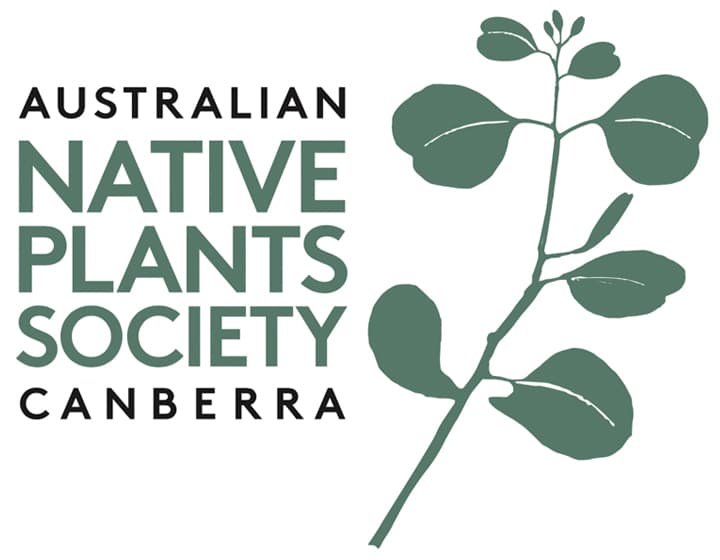Flower of Autumn
By Roger Farrow
June 2023
Alpine Gentian Gentianella muelleriana

In the alpine herbfields and subalpine grasslands of Kosciuszko National Park, when the last of the Billy Button and Snow Daisy flowers turn to seed in autumn, another flower comes into its own, the alpine gentian, Gentianella muelleriana. Its clumps of white flowers contrast with the drying grasses, spent forbs and dark heaths at this time of year. These gentians occur at altitudes of between 1900 and 2100m above the tree line in the herbfields of the Main Range. They also occur in the treeless, frost hollow, grass/sedge heaths below the tree line at 1600–1800m in places like Betts and Spencers Flats.
The alpine gentian of NSW is represented by two subspecies, G.m. subsp alpestris in the Main Range and G.m. subsp jingerensis in the Brindabella Range (Mt Gingera and elsewhere). In the Bogong High Plains of Victoria, the subspecies G.m.subsp muelleriana is present. Another subspecies G.m. subsp willisiana is restricted to the summit of Mt Buller. In older literature, G. muelleriana is called aff. diamensis, that is now restricted to the Tasmanian populations as G. diamensis. At least 30 species of Gentianella occur in alpine areas of New Zealand. The use of the genus name Chionogentias by some authorities causes yet more confusion.
Most of you will have realised that the specific name muelleriana acknowledges Ferdinand von Mueller. Species in the Australian genus Gentianella are distinguished from the cosmopolitan genus Gentiana on the basis of flower colour, blue for Gentiana and white with purple stripes for Gentianella. My intention of visiting Mt Stilwell and Betts Flats during March was to investigate the potential pollinators of these gentians. Unfortunately, my two visits were not entirely successful due to inclement weather, cool conditions on the first and high winds on the second. The visiting insects are classified as pollinators if they carry pollen grains as shown in the photographs.

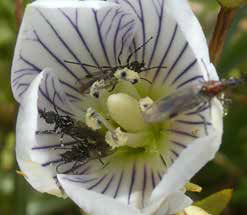
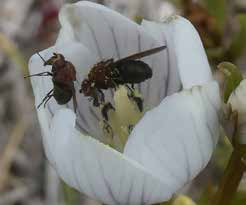
The dominant visitor at both Mt Stilwell and Betts Flats was a species of Dilophus, a March fly (Bibionidae). These flies gathered in mating clusters in the flowers, feeding on pollen at the anthers and dispersing between flower clumps, inadvertently transposing pollen between flowers. The flower shown also exhibits protandry, namely stamens maturing and opening before the central stigma opens. This promotes outcrossing and reduces possible self-pollination by visiting insects.
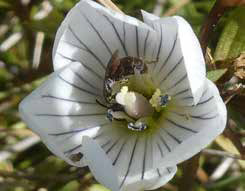
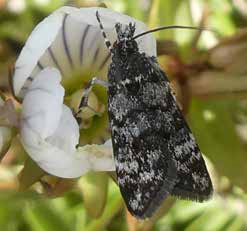
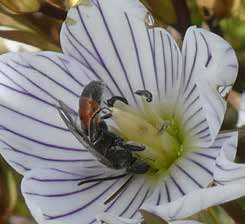
The second most abundant visitor was another pollen-feeding fly, a flower fly, Sapromyza sp. (Lauxaniidae). NB sticky pollen grains on flies. Only one solitary bee was seen in a more sheltered site below Mt Stilwell, where a few Gentians were flowering. This is a sweat bee, a species of Lasioglossum and is shown feeding on nectar but has also collected pollen and is covered in grains. This makes it a very effective pollinator as it flies from flower to flower.
Finally, there is as yet an unidentified moth visiting flowers and searching for nectar with its long proboscis. Some of these moths were seen inside the flower cup where they could pick up pollen grains. No beetle visitors were seen on the flowers at Mt Stilwell, probably because of the inclement weather at the exposed site on the saddle below the summit. But some were present on different flowers in a more sheltered snow gully (short alpine herbfield) nearby.
Moving on to the Gentians at Betts Creek Flat, bees were much more abundant here at these lower elevations. This bee is a male Lasioglossum subrussatum feeding on nectar. In this flower the stamens have withered and the stigma is open in the receptive stage, possibly trapping pollen seen on the abdomen of this bee.
There were large numbers of beetles on these flowers feeding on pollen and nectar. They all belong to an undescribed Copiacyphon sp. species of Copiacyphon in the family Scirtidae, kindly identified by Chris Watts from the South Australian Museum after my colleague Kim Pullen pointed out their family.

Members of this family have aquatic larvae, probably living in the nearby ponds, but the adults are pollen feeders and the sexes fly to the flowers where they feed and mate. Adults are shortlived but are effective pollinators as long as their emergence and dispersal corresponds to the flowering time of the gentians.
The alpine and sub-alpine species are hardly known and merit more investigation. NB The stigma of this flower is open and receptive and the anthers are withered.
Back to Articles List
